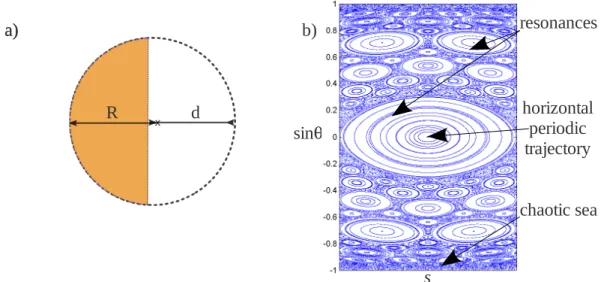HAL Id: hal-01304173
https://hal.archives-ouvertes.fr/hal-01304173
Submitted on 22 Apr 2016HAL is a multi-disciplinary open access archive for the deposit and dissemination of sci-entific research documents, whether they are pub-lished or not. The documents may come from teaching and research institutions in France or abroad, or from public or private research centers.
L’archive ouverte pluridisciplinaire HAL, est destinée au dépôt et à la diffusion de documents scientifiques de niveau recherche, publiés ou non, émanant des établissements d’enseignement et de recherche français ou étrangers, des laboratoires publics ou privés.
Phase-space control of unconventional modes for SDM
Valérie Doya, François Gustave, Claire Michel, Pierre Aschieri
To cite this version:
Valérie Doya, François Gustave, Claire Michel, Pierre Aschieri. Phase-space control of unconventional modes for SDM. ECIO 2014 Internation Conference on Integrated Optics and Technical Exhibition, Université de Nice Sophia Antipolis; LPMC, Jun 2014, Nice, France. �hal-01304173�
Phase-space control of
unconventional modes for SDM
V.
Doya, , F. Gustave, C. Michel, P. Aschieri
Laboratoire de Physique de la Matière Condensée, Université de Nice Sophia Antipolis, CNRS UMR 7336, France,
valerie.doya@unice.fr,claire.michel@unice.fr,pierre.aschieri@unice.fr
Abstract : The modes properties of highly multimode optical fibre are governed by the rays' dynamics in the geometrical limit. Different regimes of dynamics are encountered by modifying the geometry of the transverse cross section of the fibers. We show that the selection of modes in a highly multimode fiber can be simplied thanks to the signature of the rays' dynamics on the waves and exploited for spatial division multiplexing.
Unexploited until now, spatial division multiplexing (SDM) appears as the innovative way to provide the next jump in transmission capacity. A broad variety of technologies are investigated to probe the potential of SDM from multicore fibres, coupled core fibres to multimode fibres1. By using multimode fibres, transmission capacity must increase proportionally with the number of modes that act as independent transmission channels. In this active period of prospective investigations on SDM, we propose an original and challenging approach whose interest lies in transferring fundamental concepts of wave propagation in complex media to applied optical telecommunication.
Wave complexity can be induced by the geometry of a medium that governs the rays' dynamics. A silica optical fibre constitutes a natural connection between complexity and applied photonics and telecommunications. Indeed, a multimode optical fibre whom radius R is large compared with the wavelength , is a versatile system for investigating different regimes of complex rays' dynamics. Starting from a circular cross section and truncating gradually, different regimes for the dynamics are explored. The dynamics can thus be regular, chaotic or a mixture of chaos and regularity (said mixed), depending on the degree of the truncation (d).
Fig. 1 : Transverse cross section of the guiding part of the multimode fibre (a), R is the radius and d the truncation length (here d=1.05R). Poincaré surface of section associated to a mixed dynamics. s, is the curve abscissa of the ray and the angle of the ray at each reflection on the boundary (b).
In the Fig. 1b, the mixed dynamics is caracterised in the Poincaré surface of section (PSS) by the coexistence of regular islands (resonances) and distributed dots (chaotic sea). These regular and chaotic behaviours of the rays' dynamics mark the spatial properties. For instance, the called chaotic modes exhibit a statistically uniform spatial field distribution whereas the
so-d
R
s
sin
a)
a)
b)
chaotic sea
s
resonances
horizontal
periodic
trajectory
called regular modes present enhanced intensity localised on periodic rays' trajectory. The particular regular modes associated to the horizontal trajectory (periodic trajectory that closes itself after two bounces on the boundary of the transverse cross section) are of great interest because they constitute a subset of highly localised and stable modes as they are constructed on the main stable resonance of the PSS (see figure 1b). These properties made these modes more easy to excite that the thousand other modes supported by the fibre. Besides this, these modes can be seen as the longitudinal modes of a stable resonator constituted by a curve and regular reflectors separated from each other by a distance 2R-d. Thus, each mode presents enhanced intensity in the vicinity of the focus point and the value of their associated transverse wave number can easily be deduded from a standard resonance condition along the periodic trajectory :
ktnL=2n++gouy, (1) where L, is the 2 times the width of the resonator, the phase shift due to the core/cladding interface and gouy is the Gouy phase induced by the focus point. A regular mode associated to n=3 is reported in Fig. 2a.
Fig.2 : Intensity of a regular modes associated to n=3 (a). Intensity spectrum resulting from a tilted gaussian beam located on the focus point (b). Intensity spectrum associated to a phase mask illumination with a spatial modulation associated to regular modes of order n=3 (kt=14.6/R).
Each regular modes are spatially localised, that is, with a reduced spatial overlap with the other modes. Moreover, they have well-separated transverse wavenumbers (see eq. (1)). Consequently these modes should be more robust to crosstalk with other modes that may be induced by stresses on the fibre or curvatures. We claim that they can be good candidates for SDM using individual modes. Fig. 2b also shows that the regular modes can easily be excited and discriminated from the other modes by simply using a focused gaussian beam in the area of maximum of intensity (focus point).
On top of that, we may also be able to perform selective amplification of these modes by introducting a localised gain in the vicinity of the focus point, point of maximum of intensity2. References :
1. D. Richardson, J. M. Fini, L. E. Nelson, Nature Photonics, 2013.94 (2013).
2. C. Michel, V. Doya, O. Legrand, F. Mortessagne, Physical Review Letters, 99, 224101 (2007).
